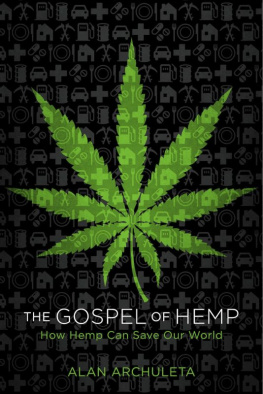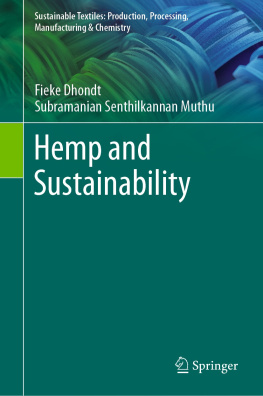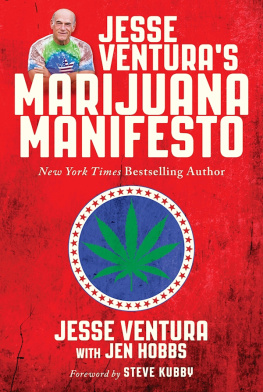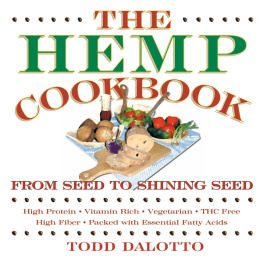
Though I do not believe that a plant will spring up where no seed has been, I have great faith in a seed. Convince me that you have a seed there, and I am prepared to expect wonders.
Henry David Thoreau
CONTENTS
INTRODUCTION
Chances are if youve picked up this book, you already know a bit about hemp. Maybe youve read about hemps potential to replace trees as the source of paper, and cotton as the source of textiles. Maybe youve even bought yourself a hemp wallet or vest. Or perhaps you are one of the growing number of people who has discovered the delicious taste of hempseed foods.
On the other hand, you may be one of the people in Arizona or California who helped pass the propositions legalizing hemps therapeutic cousin, medical marijuana, in the 1996 elections. You may even have cancer or AIDS yourself, and know firsthand the healing properties of the plant.
Then again, maybe youve never seen a hemp product or a marijuana cigarette in your life, but you are a firm believer in the democratic process and have an abiding interest in the environmental, economic, and physical health of your country and its people.
Whatever the case, youve undoubtedly had an experience similar to this: when you tell people some of the incredible facts youve learned, they are skeptical, amazed that a plant theyve always been told was a national scourge has actually proved so useful to so many for so long. But if you tell them enough, they become fascinated and want to know moreor at least want proof.
Heres where you run into problems. They arent ready to drop twenty dollars on a book about hemp, and they certainly arent going to wait around while you flip through pages hunting for confirmation of what youve been saying. This is when you pull your Hemp Manifesto out of your back pocket and press it into their palm. The facts are all here, easy to find and incontrovertible; guaranteed to make even the most skeptical listener curious enough to want to know more.
And that is the key. Education is the only way to overcome ignorance, and ignorance is the only thing holding the hemp revolution back. Because once people have the facts, they see what a good thing this plant is. This particularly applies to law enforcement and legislative bodies, both of which have been shockingly thick-headed on this issue. They are not about to educate the public on the history and current uses of cannabis, and have even worked to prevent the public from learning the facts. Though a reversal of policy on cannabis would benefit government greatly in the long run, it would be inconvenient in the short run and require some real thinking, and this is not something government does easily.
Hence, as with all revolutions, this one must begin with the people and work its way up. Once government sees how out of step with the people it has become, it will be forced to change. The pressure has already begun; it is my sincere hope that The Hemp Manifesto will help tighten the vise a few more turns.
There are two separate issues in The Hemp Manifesto, and their confusion has caused many a problem for the hemp movement, so it is important to clarify them here. Both hemp and marijuana are members of the same species, Cannabis sativa. This does not make them the same plant. Think of a beagle and a Saint Bernardboth Canis familiaris, but with utterly different looks, capabilities, and personalities. So it is with hemp and marijuana. Hemp is a stalky crop that has been grown for its fiber and edible seed for millennia; it is incapable of getting you stoned. Marijuana is a bushy form of cannabis that has been grown for its psychoactive and medicinal properties for an equally long time. The two are different plants and in two minutes a state trooper can be educated so that he will never mistake one for the other.
To avoid confusion, the first part of this book concentrates on ways that nonpsychoactive hemp has made, is making, or could make a positive impact on the world. The second part then concentrates on marijuana. The two are separate issues and you can be legitimately and completely in favor of one and against the other. But one of the truly remarkable things about Cannabis sativa is that one form of it has served humanity in the most utilitarian ways, while the other has appealed to our most spiritual and cerebral nature. Thus it seems entirely appropriate to celebrate the dual nature of this age-old ally in one book.
SAVING THE FOREST
The industrial worlds hunger for wood has already destroyed 97 percent of the mature forests of North America and the rest of the worlds forests are following close behind. Not only are forests the key to preventing loss of topsoil and pollution of waterways, they are also home to most of the worlds terrestrial species and the source of much of the worlds oxygen.
Half the trees cut down are used to make paper products, yet hemp could provide for all our paper needs. An acre of hemp yields four times as much fiber as an acre of trees, and no wildlife is destroyed in the process. With hemp we can feed our paper industry and let the forests regenerate at the same time.
PAPER FOR THE LONG HAUL
Hemp was the worlds first source of paper, invented in China around 100 B. C. Two-thousand-year-old pieces of hemp paper have stood the test of time, a feat far beyond the capabilities of wood pulp paper. In fact, if wood pulp had been the source of paper throughout history, it is terrifying to think of the history and literature we would know nothing about, foruntil the development of acid- free paperwood pulp paper disintegrated after little more than a century. A return to hemp paper would make the acid-free paper process unnecessary. Hemp paper is also stronger than wood pulp paper, naturally pliable, and partially water- resistant.
FIBERBOARD
Fiberboardcomposite board made from processed wood chips and resinsis used in cabinetry, paneling, furniture, and any other place where nonstructural wood is needed. It is one of the fastest growing segments of the wood industry. But fiberboard made from wood chips is notoriously weak. Hemp, with its long bast fibers, makes far stronger fiberboard, and thus has a wider range of applications. It is also more fireproof and insect-resistant.
INSULATION
Just as hemp fiber can replace fiberglass in cars, boats, skateboards, and other solid fiberglass products, it also makes a perfect substitute for that other famous fiberglass material: insulation. Hemp hurds (the inner core of the hemp stalk, high in cellulose) are treated with a fire retardant and then blown into space between walls. Hemp insulation produces neither the lung nor skin irritation associated with fiberglass insulation.
A MANS HEMP IS HIS CASTLE
Isochanvre, a French company, has patented a concrete substitute made by calcifying hemp stalks into a solid mass. The resulting material, also known as isochanvre, is as strong as concrete but weighs only one-seventh as much. In addition, it is more flexible, thus better able to withstand natural disasters, and is a much better insulator.
The company has already built hundreds of these all-natural houses in Europe, and the first has appeared in Canada as well. A commitment to these efficient, economical houses would significantly lessen the impact of drilling and mining on the environment.
SHOWER CURTAINS
Shower curtains are just one of the many plastic products that release toxic gasses when heated. Unfortunately, shower curtains tend to be heated a lot. Rather than be trapped in a small confined space and gassed by your shower curtain, switch to Hungarian hemp shower curtains, now on the market. Attractive, long-lasting, and naturally mildew resistant, they are the healthy alternative for your immediate environment as well as your global one.
Next page








